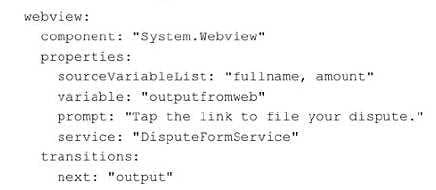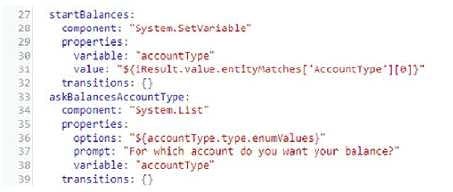Exam Details
Exam Code
:1Z0-1071-20Exam Name
:Oracle Cloud Platform Digital Assistant 2020 SpecialistCertification
:Oracle CertificationsVendor
:OracleTotal Questions
:79 Q&AsLast Updated
:Jun 24, 2025
Oracle Oracle Certifications 1Z0-1071-20 Questions & Answers
-
Question 61:
When testing your skill, you notice that two of its intents consistently rank as the top two, resolving within just a few points of each other.
Given the unpredictable nature of which intent gets the top score, what would you do to allow the skill user to choose the correct intent?
A. Change the Confidence Win Margin so that both intents are offered to the user.
B. Change the Confidence Threshold during your testing until the correct intent always wins.
C. For each intent, create an entity of phrases that are distinct to each intent, and add the appropriate entity to the corresponding intent.
D. Keep adding training data until you get a predictable result every time.
E. Change the Explicit Invocation Threshold to zero to ensure that the correct intent is picked up when the user mentions the name of the intent.
-
Question 62:
Consider this code snippet:

Which two statements about this code are true?
A. The system.webview component acts a gateway to a web app by naming the Webview service,
B. e., DisputeFormService, in the code snippet.
C. If the web app returns any values, the System.webview component will store them in the outputfromweb variable.
D. This code snippet supports only one variable as a return value from the web application. When there are multiple return values, they need to be comma-separated. For example: variable: "outputfromwebl, outputfromweb2 M
E. The web app returns two values and will store them in the fullname and amount variables, respectively.
-
Question 63:
With the conversation variable being the reference to the Bots Node SDK, which statement correctly describes what happens when the custom component executes the following code?
conversation.reply( 1 HelloWorld 1 ); conversation.keepTurn(true); done();
A. The code prints the "HelloWorld" message in response to the next user message.
B. The code triggers dialog flow navigation to a state, which has its name mapped to the current dialog flow state's HelloWorld action transition.
C. The code prints "HelloWorld" multiple times until an infinite loop gets detected by the dialog flow engine.
D. The code prints "HelloWorld" as a message and triggers dialog flow navigation to the next state.
E. The code prints "HelloWorld" as a message and waits for user input.
-
Question 64:
For live-agent transfer, you want the bot-user conversation history to become available to the human agent
that the conversation is transferred to.
How do you make this conversation history available?
A. In the skill settings, either switch Enable Insights to On or switch Skill Conversation to On, depending on the Digital Assistant version.
B. This is controlled from Oracle Service Cloud and has to be turned on by setting a custom property.
C. Set a custom property on the Oracle Service Cloud instance that's accessed by Oracle Digital Assistant.
D. Set the convHistory property in the system.Agentinitiation component.
-
Question 65:
You have gone through a number of testing iterations of your customer's skill that comprises 10 intents. But you find that generally the best you can get is a confidence score of 96%, even when the user phrase is identical to one of your training utterances. What should you recommend to your customer regarding this intent confidence score?
A. Keep iterating on user testing and add more training utterances until you can achieve a confidence level of 100% on your user input.
B. For every verb in your training utterances, ensure you add a version of the utterance which also covers the past, present, and future tense of the verb.
C. It is not always possible to achieve 100% confidence and adding more utterances may not help the problem. Therefore, do not make further changes to the skill if it is performing to your expectations.
D. The highest possible confidence with 10 intents is 10% (100% divided by the number of intents). So, no further changes to the skill are required.
E. Add more utterances to the unresolvedlntent.
-
Question 66:
Which three options are true for this dialog flow code?

A. The code is poorly programmed because the accountType variable will be set twice.
B. The system.List component always displays a list of options, regardless of the value of accountType.
C. If System.SetVariable sets accountType to a value, the System.List component does not display a list of options.
D. Usage of empty transitions is a bad practice because it can lead to unexpected results.
E. If no accountType value is set in the startBalances state, the Dialog Engine moves to the next state, askBalancesAccountType, which lists options for different account types.
-
Question 67:
Which property in system.ResolveEntities, when set to true, enables a temporary transition from the entity matching performed by this component to a state in which you may decide to call a custom component?
A. transitionMatch
B. transitionBeforeMatch
C. transitionAfterMatch
D. There is no such property, because this component is a closed system.
-
Question 68:
In reviewing a colleague's code, you note the following code in the dialog flow which takes user input and replaces the words "authorized user" or "auth user" with "AU" before then calling the intent resolution in the dialog flow with the altered string. "${utterance.value?replace('authorized user|auth user', 'AU','r')}"
Why would your colleague have done this?
A. The sentence is being normalized by replacing different versions of words such that they are aligned with the term used in the training utterances.
B. By replacing "Authorized" and "auth", one is able to bypass the usual authentication mechanism, which requires a user to log on.
C. "Authorized" and "auth" are reserved words and would fail intent resolution.
D. The above code has no impact on intent resolution.
E. The language tag is being changed to Australian (AU) to better match the language of the training utterances.
-
Question 69:
Which three statements are true about composite bag entities?
A. They define a business domain object as a collection of related system entities and custom entities.
B. When you add entities to the composite bag, you can control how they get extracted in related to other entities and when they are prompted for.
C. The composite bag will always enforce that every entity has a valid value before allowing the conversation to move on to the next state in the dialog flow.
D. You need to create a separate composite bag to handle nonentity types such as strings. Locations, and attachments.
E. The composite bag can resolve all entity values using only a single state in the dialog flow.
-
Question 70:
In a validation loop, users are repeatedly asked to enter the same information, thereby preventing them
from transitioning to a different dialoq flow state in a conversation.
What is causing the validation loop?
A. The dialog flow state uses an input component that references a nonentity type variable. The same dialog flow state is referenced in the next transition.
B. The nlpResultvariable property of the input component points to "iResult", which is a variable of type "nlpresuit".
C. The keepTurn property of the input component is set to true and the maxPrompts property is set to a value greater than 0.
D. The input component associated with a state references a variable of an entity type and the maxPrompts property is not set.
Related Exams:
1Z0-020
Oracle8i: New Features for Administrators1Z0-023
Architecture and Administration1Z0-024
Performance Tuning1Z0-025
Backup and Recovery1Z0-026
Network Administration1Z0-034
Upgrade Oracle9i/10g OCA to Oracle Database OCP1Z0-036
Managing Oracle9i on Linux1Z0-041
Oracle Database 10g: DBA Assessment1Z0-052
Oracle Database 11g: Administration Workshop I1Z0-053
Oracle Database 11g: Administration II
Tips on How to Prepare for the Exams
Nowadays, the certification exams become more and more important and required by more and more enterprises when applying for a job. But how to prepare for the exam effectively? How to prepare for the exam in a short time with less efforts? How to get a ideal result and how to find the most reliable resources? Here on Vcedump.com, you will find all the answers. Vcedump.com provide not only Oracle exam questions, answers and explanations but also complete assistance on your exam preparation and certification application. If you are confused on your 1Z0-1071-20 exam preparations and Oracle certification application, do not hesitate to visit our Vcedump.com to find your solutions here.